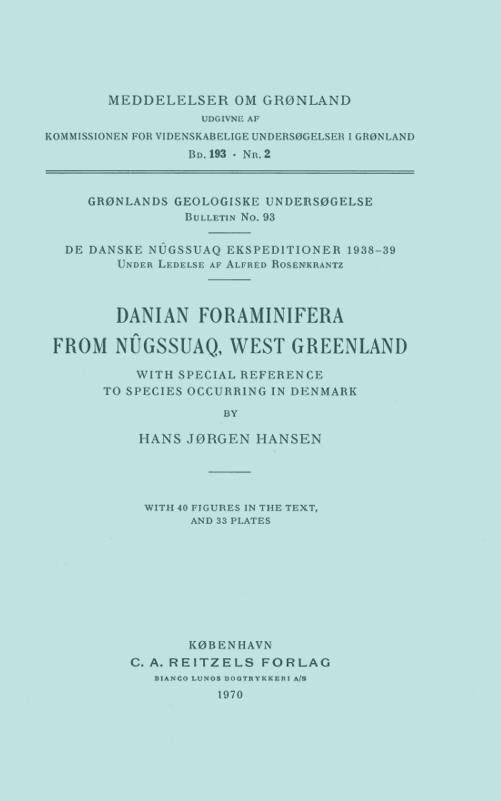Danian Foraminifera from Nûgssuaq, West Greenland, with special Reference to Species Occurring in Denmark.
DOI:
https://doi.org/10.7146/mog.v193.149643Abstract
The stratigraphy of the Lower Danian Kangilia Formation and the Upper Danian Agatdal Formation cropping out on the north coast and in the central part of Nugssuaq is discussed. The local abundance of marine fossils in the Agatdal Formation is explained as due to redeposition and transportation before the shales of the Agatdal Formation were dehydrated and compressed. On the basis of planktonic foraminifera Piz. Globoconusa daubjergensis, Globigerina compressa, Subbotina triloculinoides and Subbotina pseudobulloides the age of the Agatdal Formation is assigned to Upper Danian. The foraminiferal fauna of the Agatdal Formation is composed of 57 species. The affinity of the fauna to European Paleocene faunas is stronger than to North American faunas. The biostratigraphical zonation of Danian deposits based on the occurrence of planktonic foraminifera is discussed. In the systematic part the fauna is described and illustrated. Atlanta primigenia RAVN, 1918, originally described as a heteropod, is shown to be a foraminifer belonging to the genus Cornuspiroides. By measurement of the proloculus diameter it is shown that the distribution of megalospheric proloculi of Bulimina midwayensis remains constant from the Upper Maastrichtian to the Middle Selandian. The same character is used to distinguish Bulimina rosenkrantzi from Bulimina trigonalis and Bulimina thanetensis. On the basis of studies of wall ultrastructures of Subbotina triloculinoides it is shown that the genus Subbotina is well distinguished from the genus Globigerina. The wall of Subbotina triloculinoides is bilamellar with an overlying laminated crust like the one found in Globorotalia menardii, which phenomenon is illustrated by transmission electron micrographs. The genera Allomorphina, Quadrimorphina and Pallaimorphina are discussed. The latter is shown to be a valid genus. Allomorphina is inhomogeneous with respect to species with and without tooth-plates. Allomorphina paleocenica is an allomorphinid without tooth-plate and should accordingly be referred to a genus other than Allomorphina. The author's limited material prevents the establishment of a new genus. In Alabamina rosenkrantzi n. sp. is found a secondary closure of the foramina. Lower Tertiary alabaminas show preferred sinistral coiling. Granulate monolamellar species earlier referred to the genus Eponides are placed in a new genus Paralabamina which belongs to the family Alabaminidae. The genera Gyroidina, Gyroidinoides and the group of species morphologically close to "Gyroidina" soldanii are shown to be well distinguished in apertural characters. The genus Gyroidinoides is transferred to the family Anomalinidae, in which also Gyroidina and "Gyroidina" soldanii belong. Eight new species are described. Two belong to the genus Lenticulina, two to Fissurina, one to Rosalina, one to Pallaimorphina, one to Alabamina and one to Ceratobulimina.

Downloads
Published
How to Cite
Issue
Section
License
Coypyright by the authors and the Commision for Scientific Research in Greenland. No parts of the publications may be reproduced in any form without the written permission by the copyright owners.

